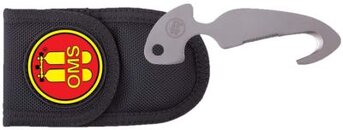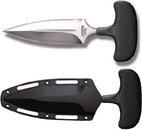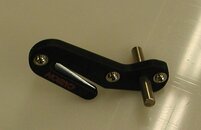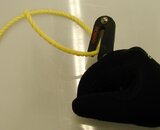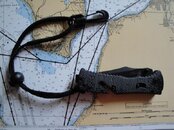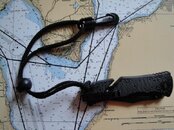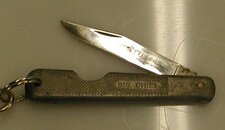Based on Akimbo's recommendation of the Z knife, and my experience with the Benchmade cutters in the EMS world, I did a comparison test of the two.
This comparison was done in a controlled environment, not in the field, so take that into consideration when interpreting the results. I also have no dive experience as I'm am only now taking my dive classes. I tried to replicate what I thought might be dive conditions.
The cutters I compared were the Benchmade 8 BLKADC and the Carbon Black Captain Knife by hookknife.com (non-functioning web site) from Sweden. I found both of them available on the parachuting web site paragear.com (I have no affiliation). Cost: Benchmade $30, Z knife $13.
Testing was done on a variety of materials in different configurations: paracord, standard rope, nylon rope, 1 webbing, tie wraps and BDUs. I used single strands and braids of 3 on the paracord and rope, and multiple thicknesses of the BDUs. I tested the cutting in air and under water.
These are the two cutters and sheaths. The first major difference is the Benchmade comes with a hard sheath and Malice clip. The Z knife has a rather flimsy nylon sheath. Additionally, the Benchmade cutter is metal, the Z knife has a plastic handle.



Next, the finger holes in the Z knife are much smaller than the Benchmade. I have small hands and can barely get a gloved finger in the Z knife hole. In contrast, when not using the finger hole, the Z knife is actually more ergonomically comfortable.




The first cutting tests were done on single strands of paracord shoelaces (EMS environment), regular rope and nylon rope.



The Z knife cut all three much easier than the Benchmade, but the design thickness of the Z knife made it hard to hook the shoelace in the boot. In open air it cut as easily as the ropes. First test advantage Z knife.
Next test was 3 strands of braided paracord, regular rope and nylon rope.

While the Z knife easily cut the braided paracord, it had a hard time with the thickness of the braided ropes into the narrow slot of the cutting space. It barely fit the nylon braid, and could not fit the regular rope braid. Advantage Benchmade.
Next was the BDUs.

This was the first real noticeable difference between the two cutters. While the Z knife cut just as easily, and possibly more easily than the Benchmade on the initial cuts of single thicknesses, it immediately began to clog with threads. Upon doubling the thickness of the cloth, the Z knife clogged drastically, and had to be taken apart. At this point, there were visible signs of damage to the Z knife blades. Advantage Benchmade.



I next tested the paracord and ropes underwater (soaked and waterlogged after sitting in the water for a period of time). The results were virtually the same as dry testing of single and braided strands. Advantage Z knife.
I tested the tie wrap (similar to six pack rings in consistency), and while the Z knife cut somewhat more easily than the Benchmade, there was more visible damage to the blades. Push.

The final test was the 1 webbing.

The initial cuts were equivalent, but the Z knife clogged again, and showed more signs of blade damage. Advantage Benchmade.

At this point I did multiple random cuts with both cutters on paracord, rope and BDU cloth. The Z knife continued to function as well or better on the single strands of paracord and rope, but again clogged on the BDU. I completely broke it down and cleaned it again. The blade damage was increased, and more noticeable. In addition, the screw heads showed signs of wear and looked as though they might strip with much more use. Advantage Benchmade.



In contrast, the Benchmade looks like it did out of the box.

In conclusion, the Z knife is a very good tool, but has its limitations under certain conditions with certain materials. Specifically, thick and/or threaded materials will cause it to fail. In addition, the life expectancy is questionable. While replacement blades are available ($4/set), the constant opening and closing of the plastic frame and weak screw heads leaves that option in question. It won many battles, but lost the war. The Benchmade needs somewhat more effort to cut smaller/thinner materials due to the curved cutting surface, but excels on the thicker ones. In medical environments, the Benchmade wins hands down. In the dive world, Id guess that the Z knife would have the edge on fishing line, light netting and the like, but probably only in its early life. Two is one and one is none, so carrying both is an option. Personally, Id also go with a pair of trauma shears as backup to either.
This comparison was done in a controlled environment, not in the field, so take that into consideration when interpreting the results. I also have no dive experience as I'm am only now taking my dive classes. I tried to replicate what I thought might be dive conditions.
The cutters I compared were the Benchmade 8 BLKADC and the Carbon Black Captain Knife by hookknife.com (non-functioning web site) from Sweden. I found both of them available on the parachuting web site paragear.com (I have no affiliation). Cost: Benchmade $30, Z knife $13.
Testing was done on a variety of materials in different configurations: paracord, standard rope, nylon rope, 1 webbing, tie wraps and BDUs. I used single strands and braids of 3 on the paracord and rope, and multiple thicknesses of the BDUs. I tested the cutting in air and under water.
These are the two cutters and sheaths. The first major difference is the Benchmade comes with a hard sheath and Malice clip. The Z knife has a rather flimsy nylon sheath. Additionally, the Benchmade cutter is metal, the Z knife has a plastic handle.



Next, the finger holes in the Z knife are much smaller than the Benchmade. I have small hands and can barely get a gloved finger in the Z knife hole. In contrast, when not using the finger hole, the Z knife is actually more ergonomically comfortable.




The first cutting tests were done on single strands of paracord shoelaces (EMS environment), regular rope and nylon rope.



The Z knife cut all three much easier than the Benchmade, but the design thickness of the Z knife made it hard to hook the shoelace in the boot. In open air it cut as easily as the ropes. First test advantage Z knife.
Next test was 3 strands of braided paracord, regular rope and nylon rope.

While the Z knife easily cut the braided paracord, it had a hard time with the thickness of the braided ropes into the narrow slot of the cutting space. It barely fit the nylon braid, and could not fit the regular rope braid. Advantage Benchmade.
Next was the BDUs.

This was the first real noticeable difference between the two cutters. While the Z knife cut just as easily, and possibly more easily than the Benchmade on the initial cuts of single thicknesses, it immediately began to clog with threads. Upon doubling the thickness of the cloth, the Z knife clogged drastically, and had to be taken apart. At this point, there were visible signs of damage to the Z knife blades. Advantage Benchmade.



I next tested the paracord and ropes underwater (soaked and waterlogged after sitting in the water for a period of time). The results were virtually the same as dry testing of single and braided strands. Advantage Z knife.
I tested the tie wrap (similar to six pack rings in consistency), and while the Z knife cut somewhat more easily than the Benchmade, there was more visible damage to the blades. Push.

The final test was the 1 webbing.

The initial cuts were equivalent, but the Z knife clogged again, and showed more signs of blade damage. Advantage Benchmade.

At this point I did multiple random cuts with both cutters on paracord, rope and BDU cloth. The Z knife continued to function as well or better on the single strands of paracord and rope, but again clogged on the BDU. I completely broke it down and cleaned it again. The blade damage was increased, and more noticeable. In addition, the screw heads showed signs of wear and looked as though they might strip with much more use. Advantage Benchmade.



In contrast, the Benchmade looks like it did out of the box.

In conclusion, the Z knife is a very good tool, but has its limitations under certain conditions with certain materials. Specifically, thick and/or threaded materials will cause it to fail. In addition, the life expectancy is questionable. While replacement blades are available ($4/set), the constant opening and closing of the plastic frame and weak screw heads leaves that option in question. It won many battles, but lost the war. The Benchmade needs somewhat more effort to cut smaller/thinner materials due to the curved cutting surface, but excels on the thicker ones. In medical environments, the Benchmade wins hands down. In the dive world, Id guess that the Z knife would have the edge on fishing line, light netting and the like, but probably only in its early life. Two is one and one is none, so carrying both is an option. Personally, Id also go with a pair of trauma shears as backup to either.



